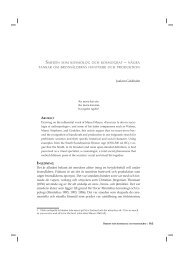rock art studies in northernmost europe, 2000 - Joakim Goldhahn
rock art studies in northernmost europe, 2000 - Joakim Goldhahn
rock art studies in northernmost europe, 2000 - Joakim Goldhahn
Create successful ePaper yourself
Turn your PDF publications into a flip-book with our unique Google optimized e-Paper software.
Pictur<strong>in</strong>g the dead<br />
One p<strong>art</strong>icular feature of the BA <strong>rock</strong> <strong>art</strong> tradition <strong>in</strong> this<br />
p<strong>art</strong> of the world is that <strong>rock</strong> <strong>art</strong> images were sometimes<br />
made dur<strong>in</strong>g different ceremonies and rituals associated<br />
with death and burials. Even after 3300 years, many of<br />
them were described as “freshly made” when they were<br />
discovered (e.g. <strong>Goldhahn</strong> 1999a). The four largest f<strong>in</strong>ds of<br />
<strong>rock</strong> <strong>art</strong> <strong>in</strong> different burials have all been revisited dur<strong>in</strong>g<br />
the last few years, <strong>in</strong>clud<strong>in</strong>g the Kivik cairn (Randsborg<br />
1993; see also Kristiansen 2004, 2005a, 2005b; Kaul 2004a:<br />
173–180; <strong>Goldhahn</strong> 2005d, 2005e, 2005f; Kristiansen and<br />
Larsson 2005); the Sagaholm barrow (<strong>Goldhahn</strong> 1999a,<br />
also Kaul 2004a); the Hjortekorg cairn (Widholm 1998,<br />
2001; also Bengtsson 2004a; Fredell 2003a; <strong>Goldhahn</strong><br />
2005c) and Mjeltehaugen (L<strong>in</strong>ge 2004, 2005; also Mandt<br />
and Lødøen 2005: 123–133). Besides these case <strong>studies</strong>,<br />
Syvertsen (2002, 2003, 2005) has analysed the portable<br />
burial slabs from Rogaland (also Nordenborg Myhre 2004),<br />
while Kaul (2004a) has discussed the f<strong>in</strong>ds that appeared<br />
<strong>in</strong> Denmark after Glob’s (1969) important survey from<br />
the late 1960s. Other important f<strong>in</strong>ds from different p<strong>art</strong>s<br />
of Scand<strong>in</strong>avia are discussed elsewhere (see <strong>Goldhahn</strong><br />
2006: 103–107).<br />
The relationship between <strong>rock</strong> <strong>art</strong> and burials is also<br />
very evident through their plac<strong>in</strong>g <strong>in</strong> the landscape. In<br />
contemporary Sweden 973 out of 6000 <strong>rock</strong> <strong>art</strong> sites (about<br />
15,000 are known) are found with<strong>in</strong> 15 m of prehistoric<br />
rema<strong>in</strong>s that are <strong>in</strong>terpreted as grave structures – about 18<br />
percent (see Widholm 1998: 80–93 for a discussion). In<br />
western Norway this relationship is very evident (Fig. 2.1),<br />
and it has been discussed and analysed by Wrigglesworth<br />
(<strong>2000</strong>, 2002, 2005; also Mandt and Lødøen 2005: 173–<br />
181).<br />
Landscapes and m<strong>in</strong>dscapes<br />
One of the most tangible qualities of <strong>rock</strong> <strong>art</strong> is that it<br />
is usually found where it was made. This phenomenon<br />
has led to a number of landscape analyses, lately under<br />
the <strong>in</strong>fluence of anthropological and phenomenological<br />
perspectives (e.g. Tilley 1994; Bender 2006) and a number<br />
of thought-provok<strong>in</strong>g analyses have been presented (see<br />
Bradley 1997, <strong>2000</strong>; Nash <strong>2000</strong>; Helskog 2001; Lewis-<br />
Williams 2002a; Nash and Chipp<strong>in</strong>dale 2002; Chipp<strong>in</strong>dale<br />
and Nash 2004).<br />
In <strong>northernmost</strong> Europe, landscape analysis has<br />
traditionally been based on the distribution of different<br />
prehistoric rema<strong>in</strong>s, such as <strong>rock</strong> <strong>art</strong>, cairns and stone<br />
sett<strong>in</strong>gs (graves), heaps of fire-cracked stones, settlements,<br />
hunt<strong>in</strong>g pits, hoards, stray f<strong>in</strong>ds, etc. (e.g. Almgren 1927;<br />
see Mandt 1972, 1991; Kjellén and Hyenstrand 1977;<br />
Nordbladh 1980; Larsson 1986; Bertilsson 1987). This<br />
is also the case dur<strong>in</strong>g the period <strong>in</strong> question here (see<br />
Bertilsson <strong>2000</strong>b; Coles <strong>2000</strong>, 2004a, 2005a; Forsberg<br />
<strong>2000</strong>; Wrigglesworth <strong>2000</strong>, 2002; Groseth 2001; Sognnes<br />
2. Rock Art Studies <strong>in</strong> Northernmost Europe, <strong>2000</strong>–2004 19<br />
Fig. 2.1. Cairns, sea and <strong>rock</strong> <strong>art</strong> (on the panel <strong>in</strong>between) at<br />
Unneset <strong>in</strong> West-Norway. Photo: <strong>Joakim</strong> <strong>Goldhahn</strong>.<br />
2001a, 2003b; Andersson 2002; Kare 2002; Nord Paulsson<br />
2002; Ramqvist 2002a; 2003; Eriksen 2003; Bengtsson<br />
2004a, 2004c; Heimann 2005; Kaul et al. 2005; Skoglund<br />
2005), but we also f<strong>in</strong>d <strong>studies</strong> which are more <strong>in</strong>fluenced<br />
by the <strong>in</strong>ternational theoretical discourse. Several of the<br />
latter <strong>studies</strong> have tried to l<strong>in</strong>k the use of the landscape to<br />
the mythology and cosmology of different societies, both<br />
with<strong>in</strong> the northern traditions (Helskog 1999, 2004; Bol<strong>in</strong><br />
<strong>2000</strong>; Bradley <strong>2000</strong>; Lahelma <strong>2000</strong>, 2005; L<strong>in</strong>dgren 2001,<br />
2002; Fandén 2002; <strong>Goldhahn</strong> 2002b; Herva and Ikäheimo<br />
2002: Nash 2002, 2004; Sognnes 2002b; Viste 2004),<br />
and those found <strong>in</strong> the south (Widholm 1998; Sognnes<br />
<strong>2000</strong>a, 2002a; Bradley et al. 2002; Thedéen 2003, 2004;<br />
Wahlgren 2002; Eriksen 2003; Syvertsen 2003; Bengtsson<br />
2004a; Kristiansen 2005a). Gjerde (2002) has analysed the<br />
different landscape perceptions between these traditions<br />
from a diachronic perspective.<br />
One crucial variable to consider <strong>in</strong> any landscape<br />
analysis is how the landscape has changed s<strong>in</strong>ce the <strong>rock</strong><br />
<strong>art</strong> was made (Sognnes 2001a; Gjerde 2002; Helskog<br />
2004; Engelmark and Larsson 2005). In the northern p<strong>art</strong>s<br />
of Europe, the shore displacement after the last glacial is<br />
very evident and important to consider (see Helskog 1999,<br />
2004; Ramstad <strong>2000</strong>; Sognnes 2001a, 2003a; Bradley and<br />
Phillips 2004; Coles 2004a, 2005a; L<strong>in</strong>g 2004, 2005, 2006;<br />
Seitsonen 2004), but this fact has often been neglected.<br />
For <strong>in</strong>stance, the “agrarian <strong>rock</strong> <strong>art</strong>” from Bohuslän (e.g.<br />
Almgren 1927; see Nordbladh 1980; Bertilsson 1987;<br />
Fredell 2003a; Bengtsson 2004a; Vogt 2006), nowadays




